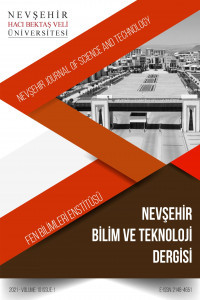Trifluralin,Treflan ve Etil Metan Sülfonatın Oreochromis niloticus’ta Oluşturduğu Genotoksik Hasar Üzerine Askorbik Asitin Antigenotoksik Etkisi
Bu çalışmada askorbik asitin (vitamin C) muhtemel antigenotoksik etkisi, ticari değeri olan balık türü Oreochromis niloticus (Nile Tilapia)’un eritrositlerinde mikronukleus ve nuklear anomali testleri kullanılarak değerlendirilmiştir. Balıklar; herbisit etken maddesi trifluralin ve ticari formu treflanın (litrede 480 gr trifluralin ve ticari olarak özel bileşenler) genotoksik konsantrasyonlarına (10 µg/L), pozitif kontrol olarak etil metan sülfonata (EMS) (10 mg/L) 6 gün boyunca maruz bırakılmıştır. Trifluralin, treflan ve etil metan sülfonat konsantrasyonları, içerisinde 10 litre musluk suyu bulunan 30x20x15cm ebatlarındaki akvaryumlara eklenmiştir. Musluk suyu negatif kontrol olarak kullanılmıştır. Askorbik asit (%0.05) balıklara intraperitonal olarak maruziyetin 1. ve 3. günlerinde 0.1ml/10g vücut ağırlığı olacak şekilde uygulanmıştır. Askorbik asitin herbisitlerin oluşturduğu genotoksik hasarı düzenleyici etkisi mikronukleus ve nuklear anomali testi ile değerlendirilmiştir. Analiz sonuçları; trifluralin, treflan ve etil metan sülfonat uygulamalarının balık eritrositlerinde genotoksik hasarı yükselttiğini göstermiştir. Ancak, kimyasallarla kombine şekilde askorbik asit uygulaması hasarlı hücre oranını önemli derecede azaltmıştır. Sonuç olarak, askorbik asit herbisitler tarafından oluşturulan genotoksik hasara karşı koruyucu etki göstermiştir. Bu nedenle balık çiftliklerinde genotoksik hasarın önlenmesi/azaltılması amacıyla yemlerde askorbik asit kullanılabilir.
Anahtar Kelimeler:
Antigenotoksik, askorbik asit, mikronukleus, Oreochromis niloticus, Trifluralin
Antigenotoxic Effect of Ascorbic Acid on Genotoxic Damage in Oreochromis niloticus Induced by Trifluralin, Treflan and Ethyl Methane Sulfonate
In this study, possible anti-genotoxic effect of ascorbic acid (vitamin C) was investigated by micronucleus and nuclear abnormality test in peripheral erythrocytes of a commercially important fish species, Oreochromis niloticus, (Nile Tilapia). The fish were exposed to genotoxic concentrations of trifluralin (10 µg/L), and its commercial form, Treflan (10 µg/L, composition: trifluralin 480 g/L and commercially-confidential components) and ethyl methane sulfonate (EMS) (as a positive control, 10 mg/L) for 6 days. Trifluralin, treflan and EMS were administered to living space (30x20x15cm aquarium and 10 liter tap water) of fish. Tap water as negative control was used. Ascorbic acid (0.05 %) was injected to the fish by intracoelomic route as 0.1 ml/10 g body weight at the 1st and 3rd days of exposures to trifluralin. The genotoxic effects of the herbicides and possible anti-genotoxic effect of ascorbic acid were evaluated using the micronucleus test and nuclear abnormality. Analysis of the results showed that applied concentrations of trifluralin, treflan and EMS increased the frequency of micronucleated cells. However, in the fish administrated ascorbic acid along with trifluralin, treflan and EMS there was a significant decrease in percentage of micronuclei as compared to trifluralin, treflan and EMS treated fish. In conclusion, ascorbic acid ameliorated the genotoxicity by the herbicides and therefore we may suggest the use of this reducing agent for the prevention of genotoxicity in fish farming.
Keywords:
Antigenotoxicity, ascorbic acid, Micronucleus, Oreochromis niloticus, Trifluralin,
___
- Fetoui H., Makni M., Garoui E.M., Zeghal N., “Toxic effects of lambda-cyhalothrin, a synthetic pyrethroid pesticide, on the rat kidney: Involvement of oxidative stress and protective role of ascorbic acid” Experimental and Toxicologic Pathology, 62, 593–599, 2010
- Ghiazza G., Zavarise G., Lanero M., Ferraro G., “Sister chromatid exchanges induced in human lymphocyte chromosomes by trifluralin, atrazine and simazine” Bollettino Della Societa Italiana di Biologia Sperimentale, 11, 2149-2153, 1984
- Pilinskaia M.A., “ Evaluation of the cytogenetic effect of the herbicide treflan and of a number of its metabolites on mammalian somatic cells” Tsitologia Genetica, 21(2), 131-5, 1987
- Könen S., Cavas T., “ Genotoxicity testing of the herbicide trifluralin and its commercial formulation Treflan using the piscine micronucleus test” Environmental Molecular Mutagenesis, 49, 434-438, 2008
- Hooftman R.N., “The induction of chromosome-aberrations in Notobranchius rachowi (Pisces, Cypridontidae) after treatment with ethyl methane sulfonate or benzo[a]pyrene” Mutation Research , 91(4- 5), 347-352, 1981
- Guha B., Khuda-Bukhsh A.R., “ Efficacy of vitamin-C (L-ascorbic acid) in reducing genotoxicity in fish (Oreochromis mossambicus) induced by ethyl methane sulphonate” Chemosphere, 47, 49–56, 2002
- Ames B., “ Dietary carcinogens and anticarcinogens” Science, 221, 1256-63, 1983
- Block G., “Vitamin C and cancer prevention: The epidemiologicalevidence” American Journa of Clinical Nutrition, 53, 270-80, 1991
- Byers T., Perry G., “ Dietary carotenes, vitamin C and vitamin E as protective antioxidant in human cancer” Annual Review of Nutrition, 12, 139-59, 1992
- Kaya B., “ Antigenotoxic effect of Ascorbic acid on mutagenic dose of three alkylating agents” Turk Journal Biology, 27, 241-46, 2003
- ISSN: 2148-466X
- Yayın Aralığı: Yılda 2 Sayı
- Başlangıç: 2012
- Yayıncı: Nevşehir Hacı Bektaş Veli Üniversitesi
Sayıdaki Diğer Makaleler
Avanos İlçe Merkezinde Trafik Kaynaklı Gürültü Kirliliğinin Mekansal Analizi
Davranışsal Pediatrik Besleme Değerlendirmesi Ölçeği (DPBDÖ)’ni Türkçe’ye Uyarlama Çalışması
Seda Önal, Esra Çalık Var, Aslı Uçar
Emaye Kaplama Endüstrisi Atıksularının Klasik Ve Modifiye Fenton Prosesleri İle Arıtımı
